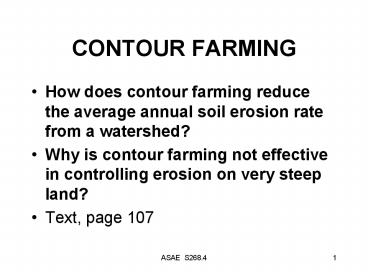CONTOUR FARMING - PowerPoint PPT Presentation
1 / 39
Title:
CONTOUR FARMING
Description:
Concept used in ancient mountainside farming systems in Asia and South America. ... Bench Terraces in Japan. ASAE S268.4. 26. Bench Terraces in the US. ASAE S268.4. 27 ... – PowerPoint PPT presentation
Number of Views:2000
Avg rating:3.0/5.0
Title: CONTOUR FARMING
1
CONTOUR FARMING
- How does contour farming reduce the average
annual soil erosion rate from a watershed? - Why is contour farming not effective in
controlling erosion on very steep land? - Text, page 107
2
CONTOUR STRIP CROPPING REDUCES EROSION BY
- Each year only part of the field is open to the
highest erosion rates - Erosion from open strips is trapped in the
vegetation on the close-growing strips.
3
FUNCTIONS OF TERRACESFrom ASAE Standard ASAE
S268.4
- Reduce Soil Erosion
- Retain Soil Moisture For Crop Use
- Remove Surface Runoff w/o erosion
- Create level land for farmability
- Control Sediment Loss from Fields
- Reduce Peak Runoff Rates
- Improve Water Quality
4
TERRACES FOR EROSION CONTROL
- Terraces affect the topographic factor on the
USLE (LS). - To be effective for field erosion control
terraces need to be spaced at nearly constant
vertical intervals. - For Sediment Control terraces need to be level or
at a very flat slope, particularly at the lower
end.
5
Terrace System Classification
- Parallel or Non Parallel
- Gradient or Level
- Cross-Section
- Outlet Type
6
PARALLEL GRADIENT TERRACE SYSTEM
7
PARALLEL LEVEL TERRACE SYSTEM
8
Nonparallel Gradient Terrace System
9
Parallel Gradient Terrace System
10
(No Transcript)
11
(No Transcript)
12
(No Transcript)
13
Broadbase TerraceCross-section
14
Broadbase Terrace
- Designed to fit smoothly in the field so that
machinery can work the entire area. - Used for erosion control and to retain soil
moisture - May be constructed with level or graded channels.
- Limited to field slopes lt8
15
Steep-Backslope Terrace Cross Section
16
Steep-Backslope Terrace
- Developed for use on field slopes too steep for
Broadbase terraces. - Push-up construction reduces overall field slope.
- Backslope is a barrier to machine travel.
Normally planted to permanent grass. - Less effective for field erosion control
17
Narrow-Base TerraceCross-Section
18
Narrow-Base Terrace
- Steep Ridge on both sides planted to grass
- Less expensive to construct than broadbase or
steep backslope cross-sections.
19
Ridgeless-Channel Terrace Cross-Section
20
Ridgeless-Channel Terrace
- Designed for nearly level land
- Cut soil spread between terraces
- Little interference with field machine
operations. - Low cost construction
21
Conservation Bench Terrace Cross-section
22
Conservation Bench Terrace
- Moisture Conservation in semi-arid locations with
field slopes lt5 - Layout includes a watershed area above and the
flat channel to catch runoff from the watershed. - Watershed area 2 to 4 times channel area,
depending on expected runoff.
23
Bench TerraceCross-section
24
Bench Terrace
- Used to create level land for farming,
particularly with surface irrigation. - Concept used in ancient mountainside farming
systems in Asia and South America. - Used in irrigated areas in the American west.
25
Bench Terraces in Japan
26
Bench Terraces in the US
27
Terrace System Spacing
Slope VI / HI x 100
VI
HI
28
VI XsYEq. 7.1, p. 116 in Text
- VI is the Vertical Interval between terraces in
Feet - s is the Field Slope between terraces in percent
- HI Horizontal Interval or spacing
- s VI / HI 100 (definition of field slope)
- HI VI / s 100
29
VI XsYEq. 7.1, p. 116 in Text
- X is a factor that depends on the climate
(rainfall) in the area - Related to R in the USLE
- See Fig. 7.10, page 117 in the Text
- 0.4 lt X lt 0.8
- Higher value for less rainfall
- Use 0.7 for Iowa
30
(No Transcript)
31
VI XsYEq. 7.1, p. 116 in Text
- Y is a factor that depends on the soil
erodibility and cover protection - Related to K and C in the USLE
- Lower Value for easily eroded soil with little
cover protection - 1 lt Y lt 4
- Use Y 2 for average field conditions
32
TERRACE SPACING
- Estimate the required terrace spacing for average
field conditions on a 5 slope in Northern
Arkansas. - From Fig. 7.10 X 0.5
- For average field conditions Y 2
- VI (0.5)(5)2 2.52 4.5 ft
- HI (4.5/5)(100) 90ft.
33
GRADES IN TERRACE CHANNELS
Would there be more erosion at the top or bottom
of a slope? Why?
34
GRADES IN TERRACE CHANNELS
A
B
C
Which of these slopes would have the most
erosion, and why?
35
GRADES IN TERRACE CHANNELS
- The allowable terrace channel grade is greatest
at the upper end of the terrace. - When water removal is a concern, terraces have a
minimum grade requirement to prevent ponding - See table 7.2, page 119 in text.
36
MAXIMUM TERRACE LENGTH
- The maximum terrace length is based on a maximum
drainage area. - Terrace channels should drain no more than 3
acres of watershed - Length x Spacing Drainage Area
37
Parallel Gradient Terrace System
38
Terrace Channel Water Storage
- Runoff Volume Length x Spacing x Depth of
Runoff - Storage Volume Length x X-section Area
- Required X-section for Storage Spacing x Depth
of Runoff - L x S x D L x A
- S x D A
39
Terrace Channel Water Storage
- Terrace Length 500 ft
- Terrace Spacing 100 ft
- Runoff Depth 0.2 ft
- Runoff Volume 500 x 100 x 0.2 10000 ft3
- Storage Volume 500 x Area
- 10000 500 x Area
- Area 10000/500 20 100 x 0.2































